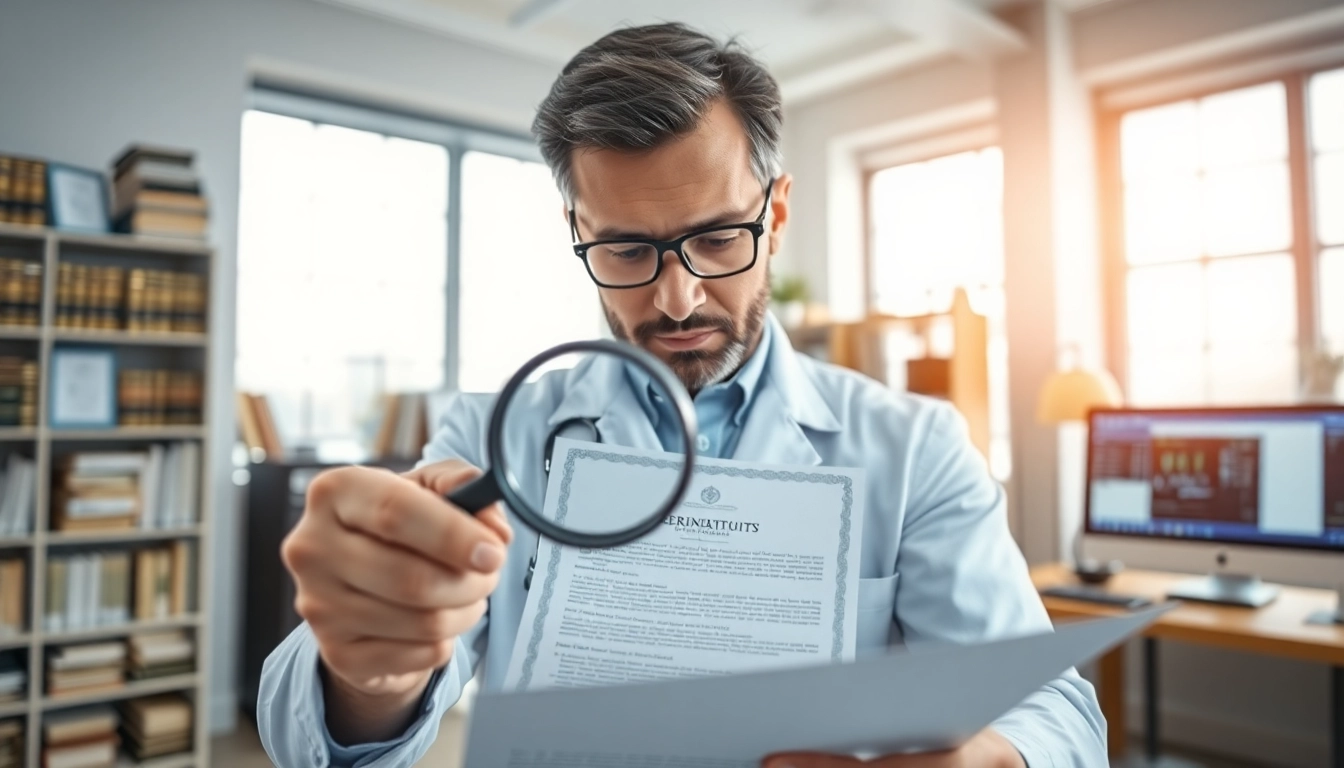Understanding Document Verification
In an increasingly digital world, the authenticity of documents is under constant scrutiny. Whether it’s for legal, financial, or personal matters, the question arises: How do I know this document is real? Understanding how to verify the authenticity of documents is crucial for both individuals and businesses to protect themselves from potential fraud and legal repercussions.
What is Document Authenticity?
Document authenticity refers to the verification that a document is genuine and has not been altered or forged. Authentic documents carry the necessary signatures, official seals, and elements that signify their legitimacy. Authenticity can be paramount in various contexts, such as employment agreements, legal contracts, alterations to government forms, and educational certifications.
Importance of Verifying Documents
Verifying documents is critical to maintain trust in personal, professional, and civic relationships. Verification helps in:
- Preventing Fraud: Ensuring that documents are authentic can prevent fraudulent activities that could lead to significant financial losses or legal troubles.
- Maintaining Reputation: Businesses that fail to verify documents risk reputational damage if they inadvertently engage with fraudulent entities.
- Legal Compliance: Many regulatory bodies require verification of documents as part of compliance processes.
Common Types of Fake Documents
Understanding the most common types of fraudulent documents can aid in quick identification:
- Identification Cards: Fake IDs are among the most commonly forged documents, often used for age verification or identity theft.
- Academic Certificates: Counterfeit diplomas and transcripts can have serious implications for hiring and academic credentials.
- Financial Statements: Fake bank statements or financial records can be used to fraudulently obtain loans or credit.
- Government Forms: Forged documents, such as tax returns or permits, can be created to evade legal obligations.
Methods to Verify Document Authenticity
There are several effective methods to ascertain the authenticity of documents that can help in reducing the risk of fraud:
Check for Official Seals and Signatures
Most official documents carry distinct seals, embossed or printed, that indicate authenticity. Following are effective ways to verify these seals:
- Visual Inspection: Look for signs of tampering or reproduction in the seals or signatures. Counterfeit seals may appear uneven, faded, or lack the crispness of genuine ones.
- Contact the Issuer: When in doubt, contact the institution that supposedly issued the document to confirm its authenticity.
- Use Light or Magnification: Viewing a document under UV light or using a magnifying glass can reveal features not visible to the naked eye, such as watermarks.
Utilize Verification Tools and Software
In the digital age, technology offers numerous solutions to verify documents:
- Document Authentication Services: Various platforms provide services to verify the legitimacy of documents using advanced algorithms.
- QR Codes: Many organizations use QR codes on their documents that can be scanned to check their validity against a secure database.
- Blockchain Technology: This emerging technology ensures document integrity by creating tamper-evident records that are easily verifiable.
Consult with Experts and Authorities
When the stakes are high, consulting professionals may be the best option:
- Forensic Document Examiners: Specialized experts analyze documents for authenticity and can testify in legal matters if necessary.
- Legal Authorities: Many countries have departments dedicated to handling fraud and can provide guidance on verifying document authenticity.
- Industry-Specific Professionals: Depending on the document type, contact professionals who specialize in that area (e.g., academic institutions for diplomas).
Analyzing the Signs of Fraud
Recognizing fraud in documents requires a keen eye and knowledge of common signs:
Recognizing Red Flags in Documents
Indicators of possible document fraud can be overt or subtle. Key signs include:
- Inconsistent Information: Check for discrepancies in dates, names, or other details that may indicate forgery.
- Poor Quality Printing: Low-resolution printing or uneven text can suggest a document is not authentic.
- Unprofessional Layout: Authentic documents usually adhere to a recognized format or layout that forgeries often overlook.
Understanding Forgery Techniques
Knowing how fraudsters operate can aid significantly in detection:
- Alteration: Original documents may have details altered, often using correction fluid or digital editing.
- Counterfeiting: Full reproduction of a document, often used for checks and ID cards, might involve detailed printing techniques.
- Impersonation: In some cases, fraudsters may try to create fake documents purporting to be from legitimate sources to gain access to resources.
Case Studies of Document Fraud
Real-world examples can be enlightening in illustrating the ramifications of document fraud:
- Corporate Fraud: There have been instances where executives created fake financial documents to secure investments based on misleading revenue reports, resulting in millions of dollars lost.
- Educational Forgery: A significant number of job applicants have been found using fake diplomas from non-existent universities, challenging hiring processes.
- Real Estate Scams: Fraudulent documents in real estate have led to legitimate buyers being scammed out of their life savings.
Legal Implications of Using Fake Documents
The legal consequences of using or even being in possession of counterfeit documents can be severe:
Consequences of Forgery
Legal repercussions for creating, using, or possessing fake documents include:
- Criminal Charges: Individuals found guilty of forgery can face stiff penalties, including prison time and fines.
- Civil Liabilities: Victims of fraud may pursue lawsuits resulting in costly settlements or judgments.
- Employment Consequences: Professionals caught using fake documents often face job termination and difficulty securing future employment.
Reporting Fraudulent Documents
If you discover or suspect document fraud, it’s crucial to take immediate action:
- Notify Authorities: Report suspect documents to law enforcement or relevant regulatory agencies.
- Contact Institutions: Inform the institutions that have issued the documents to ensure they are aware of potential fraud.
- Document Everything: Keep copies of the original documents and records of your communications when reporting the fraud.
Protecting Yourself Legally
To guard against the legal repercussions of engaging with fraudulent documents:
- Conduct Diligent Research: Always check the authenticity of important documents before making decisions based on them.
- Keep Detailed Records: Maintain comprehensive documentation regarding the authentication processes you use to protect yourself.
- Train Employees: For business owners, educating staff about document verification techniques is vital in preventing exposure to fraud.
Best Practices for Document Handling
Implementing best practices in document management can significantly reduce risks associated with fraud:
Storing Documents Securely
Proper storage can help to prevent unauthorized access to sensitive documents:
- Physical Security: Use locked filing cabinets and restricted access areas to store important paper documents.
- Digital Security: Employ encryption and secure access protocols for electronic documents to prevent tampering.
- Backup Copies: Regularly back up important documents in secure locations to safeguard against loss.
Educating Yourself and Others
Knowledge is the first line of defense against document fraud:
- Training Sessions: Organize regular training for employees on recognizing the signs of document fraud.
- Updates on Regulations: Stay informed about monitoring requirements and updates in laws regarding document handling.
- Resource Allocation: Invest in tools and resources that facilitate ongoing education about document verification.
Regular Audits of Documentation Processes
Performing periodic audits can help catch issues early:
- Review Procedures: Regularly re-evaluate the processes in place for document verification and update them as necessary.
- Check Compliance: Ensure that all documentation adheres to legal and regulatory requirements to minimize risk.
- Feedback Mechanism: Create channels for employees to report vulnerabilities or irregularities in document processes.



